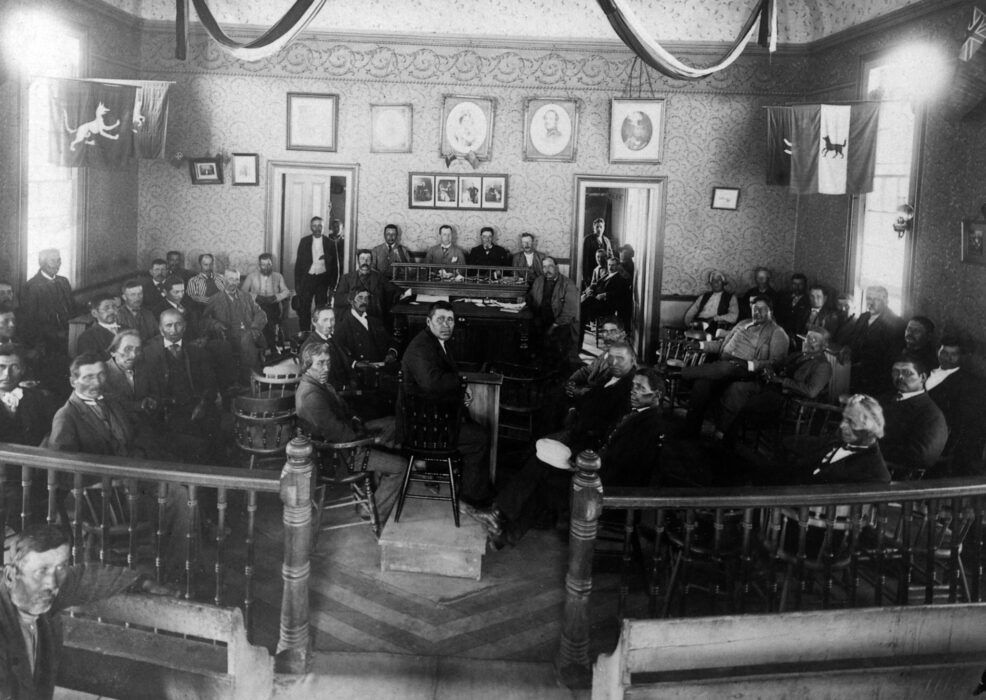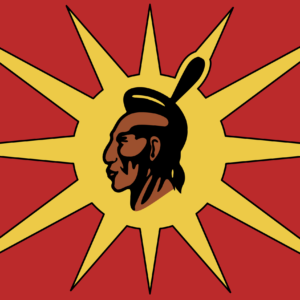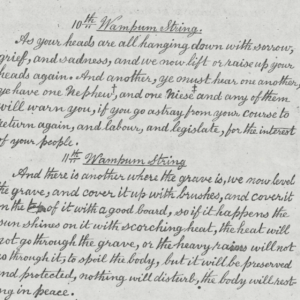
he Haudenosaunee Confederacy Chiefs Council has been long criticized for their lack of transparency and accountability with the Six Nations people.
Now, they are being trolled by Haudenosaunee people for not knowing their own history.
In October, an embarrassing ad campaign was sponsored with misleading and inaccurate information about a historical black and white photo depicting the chiefs in council.
The photo was an image of the chiefs in council at the Six Nations Council House on Fourth Line in Ohsweken. Within the comments, the Haudenosaunee Confederacy official page began responding to comments from the community and identified the image as one taken “right before the RCMP removed the council at gun point”.
The image was definitely not taken right before RCMP removed the council at gun point. In part, because the confederacy chiefs were never removed from council at gunpoint.
The photo is, in fact, part of a series of images taken of Six Nations in 1914. Copies of this image are archived with the Marquette University Archives – a Catholic Jesuit university in Milwaukee, Wisconsin. It is listed under file 01259 in part of a digital collection on American Indian history.
It appeared in a report titled “The Administration of Indian Affairs in Canada” by Frederick H. Abbott from the United States Board of Indian Commissioners and was published in 1915.
Abbott writes that the population of Six Nations at that time was 4692 people including 1955 Mohawks, 377 Onondagas, 441 Tuscaroras, 1117 Cayuga, 230 Senecas, 177 Delawares and 395 Oneidas.
He sat in session with the chiefs council and writes, “I saw the council of the Six Nations opened by the Onondaga chief with the same ceremony that has opened the councils of this famous confederacy for the last 300 years; heard the chief offer thanks to the Great Spirit for protecting the chiefs sine their previous meeting and praying for his protection of the present proceedings; saw the same belt of wampum spread over the table, which had been used in connection with meetings of the council for three centuries.”
The assessment of the community contained descriptions of land transactions, schools and included images of the former home of Chief William Smith at the corner of Mohawk Road and First Line as well as an image of the Six Nations Agricultural Fair on its 48th anniversary.
It is evident that a photo taken and published in 1915 is not a picture of the chiefs prior to them being removed by RCMP at gunpoint.
The public is again being spoon fed more rhetoric and revisionist history by the HCCC on their official social media accounts in a paid, cross-platform social media campaign and the hereditary leaders of the community should be investigating who is responsible.
The hereditary chiefs of Six Nations were never “removed at gunpoint” from the council house in Ohsweken by the RCMP. This is a rumour that is continuously peddled by HCCC spokespeople, perhaps to up the shock value of the deposition of the hereditary appointment of leaders in 1924.
But those are not the facts.
To read a true account of what happened one just needs to turn to the hereditary chiefs own notes about the day.
“Agricultural Hall
Oct 7, 1924
General Council of the Chiefs of the Six Nations was held at the Agri Hall, the Council House being under repairs opened in due form by Chief Geo. Davis one of the Fire Keepers.
Present: Col. CE Morgan, Superintendant of Indian Affairs; Mr HM Hill, Clerk Indian Office; Chief JC Martin, Acting Speaker; Chief C Garlow, Deputy Speaker and DS Hill, Secretary.
And 19 chiefs with about a score of RCMP accompanying Agent Morgan.
The Agent read a length proclamation dissolving the Six Nations Council of Chiefs and appointing a day for an election day under a clause of the Indian Act.”
There is no record of the chiefs or their meeting being interrupted by being forcibly removed from the council house at gunpoint that day because it didn’t happen. The minutes show the council carried on with business at the Agricultural Hall after the proclamation was read, settling William Johnson’s estate, approving land leases on the territory, assigning guardianship of children over to family members in the community and settling the honorarium for secretary Chauncey Garlow.
Council minutes show that the hereditary chiefs met again on October 21, 1924 at Upper Cayuga Longhouse and made more decisions — with JC Martin, C Garlow, David S Hill and 20 chiefs in attendance. This meeting included a land tax of “10 cents per acre upon all lands on the Reserve for the purpose of the redemption of Bonds issued when due in 1928 as arranged for by the Council.” It also included formal minutes about the community opposition to the installation of elected chiefs.
So was this blatant misinformation? Or is it a case of someone who is not skilled in Six Nations history at the helm of a paid advertising campaign on social media? Leadership at the council need to investigate and for the sake of building trust in the community — ensure that they are only distributing factual information to the public through their official channels. Spreading misinformation, especially about our history, does not build a strong case for being an effective governing body capable to manage Six Nations in any capacity.






